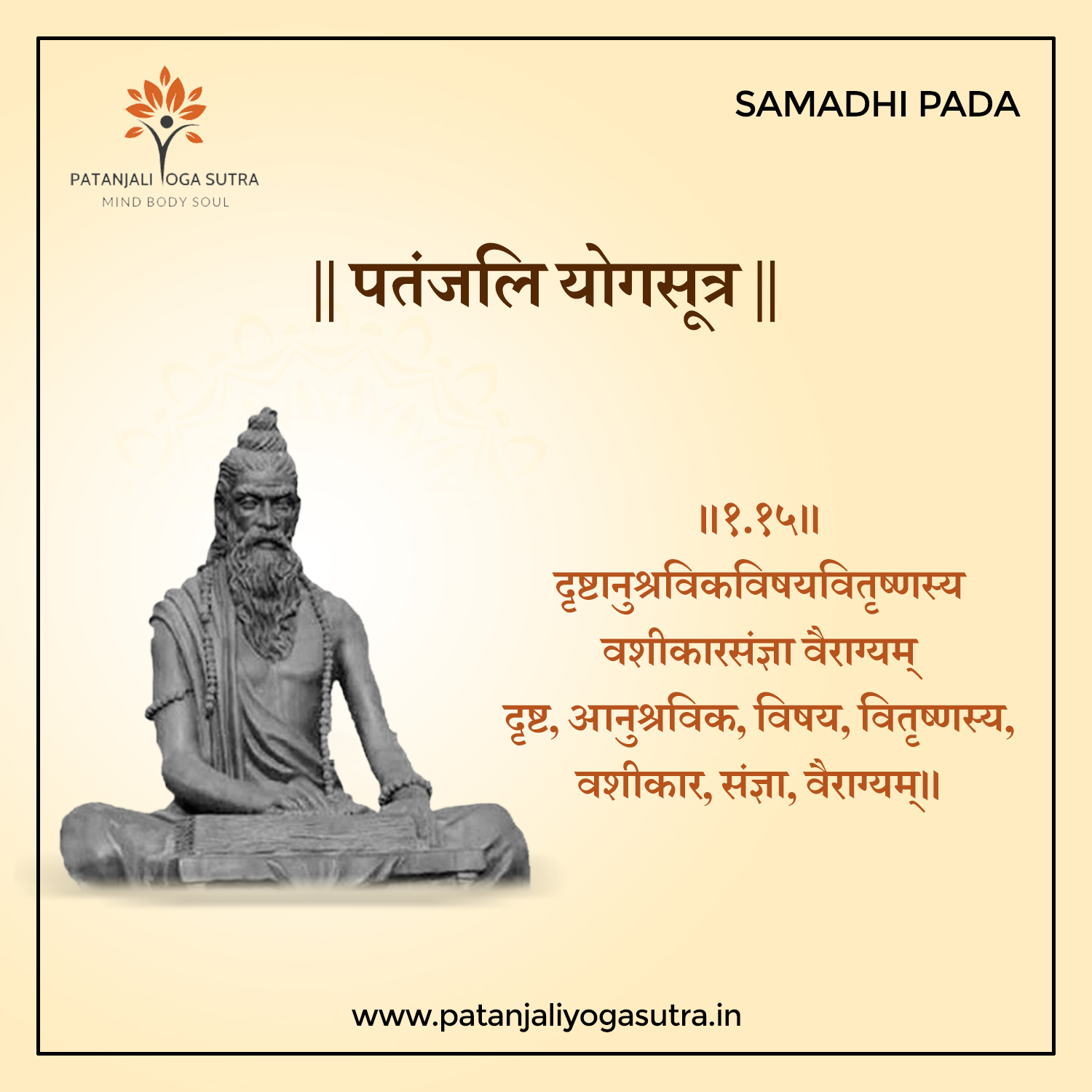



अब वैराग्य के स्वरुप अर्थात उसके वास्तविक रूप को समझने का प्रयास करते हैं | जैसे कि पहले भी मैं कह चुका हूँ अभ्यास और वैराग्य को सटीकता से समझने का प्रयास अवश्य करना चाहिए क्योंकि ये बहुत महत्वपूर्ण हैं योग साधना में गति पाने के लिए |
महर्षि कहते हैं-”दृष्ट अर्थात देखे हुए विषयों में और आनुश्राविक अर्थात सुने गए विषयों में तृष्णा रहित योगी की मन और इन्द्रियों पर पूर्ण रूप से नियंत्रण की स्थिति या अनुभूति वैराग्य कहलाती है ”
देखे गए विषय हैं (दृष्ट)- आँख का विषय (सांसारिक सौन्दर्य), रसना के विषय (स्वादिष्ट अन्न, स्वादिष्ट पेय) ऐश्वर्य आदि | जब तक इन देखे जाने वाले विषयों में भोगासक्ति बनी है तब तक वैराग्य उद्घाटित नहीं हो सकता है | लेकिन ऐसा नहीं है कि तो जो योगमार्ग में आरूढ़ करने वाले साधन हैं उनका सहारा नहीं लेना है, वे हेय नहीं है यदि वे आपको साधना के मार्ग पर चला रहे हैं तो, इसका निर्धारण साधक को स्वयं में करना पड़ता है|
सुने हुए विषय हैं (आनुश्राविक)- शास्त्रों के द्वारा जो सुने जाते हैं और जिनका कोई प्रत्यक्ष अनुभव साधक को नहीं होता है उन्हें आनुश्राविक विषय कहा जाता है | यदि इन सुने हुए विषयों में मन फल की कल्पना कर रहा है या किसी भी तरह चित्त इसमें लोभ भावना से लिप्त है तो यह स्थिति भी योग में बाधक है और वैराग्य का नाश करने वाली है | इसलिए इन सुने हुए विषयों को केवल शुद्ध ज्ञान की दृष्टि से समझने मात्र से चित्त निर्मल बना रहता है |
जब साधक का चित्त उपरोक्त दोनों प्रकार के विषयों से निर्लिप्त होकर जीवन साधना में आगे बढ़ता है तो उसके भीतर एक सहज वैराग्य उदय होता है जो विवेक और अभ्यास के साथ मिलकर समाधि के मार्ग पर साधक को आगे बढ़ाता है |
वैराग्य को यदि सीधे शब्दों में कहें तो निर्लिप्तता, तृष्णा से रहित चित्त, लोभ से रहित चित्त |
योगदर्शन के अनुसार इसे अपर वैराग्य भी कहा जाता है और यह सम्प्रज्ञात समाधि का उपाय है |
Now let us try to understand the real form of vairagya/non attachment. As said earlier, it is very important to understand accuracy of abhyasa and detachment because they are very important to proceed in Yoga sadhana.
According to Maharishi, “Lack of craving for objects, seen or described in scriptures, enables the yogi to acquire a state of desirelessness and complete control over senses. This level of desirelessness is called vairagya”.
Class of objects seen/perceived: Women, health, food, wine and wealth. Detachment is not possible till the time you have craving for these worldly affairs. But this does not mean that these worldly pleasures cannot be used even if they guide the yogi onto the path of meditation.
Class of heard/described objects: The objects heard/described are the objects from the experiences of others, mostly through scriptures. The meditator does not have first- hand experience of them. The situation, in which the mind starts imagining some sort of reward as a result of heard objects or becomes greedy, is also an obstacle in Yoga and destroys vairagya. Therefore, taking these heard objects as pure knowledge keeps the mind immaculate.
When the yogi’s mind remains uninspired by the above mentioned temporal objects then he moves ahead in life feeling natural quietness, which coupled with intellect and practice, leads him on the path of complete absorption.
Vairagya/dispassion in simple words means a mind without any craving for worldly pleasures or temptations. It is called Apara vairagya in Yoga Darshana and it is the way to sampragyat Samadhi.
सूत्र: दृष्टानुश्रविकविषयवितृष्णस्य वशीकारसंज्ञा वैराग्यम्
जो कुछ देखा – सुना है अब तक
तृष्णा रहित न हो जाएं जब तक
पूर्ण नियंत्रण हो इंद्रियों और मन पर
जो नहीं किया था तुमने जीवन भर
इसे ही वैराग्य महर्षि कहते हैं
अभ्यास करो, तुमसे कहते हैं।
Such a systematic presentation of Patanjali Yog Sutras! Appreciate the hardwork done by the team! 🦋🌟
thanks shifa. thanks for the kind words
Hey! Just wanted to say great website. Keep up the good work!
Thank you
ओ३म् नमस्ते जी website के द्वारा हम जीवन को धीरे धीरे जीवन को एक राह दे सकते है
धन्यवाद जी
Wonderful site.
धन्य वाद स्वामीजी इस सुंदर वेब साईट के लिये.
इससे सभी लोगो को बहुत सहायता मीलेगी!!
Thank u so much for such a fantastic knowledge
Good job congrats
Wonderful work done by team to make PY available for all.
Thanks. Felt blessed. Please do check explanation audio as it’s working only for first 3-4 sutras.
Excellent effort. My only observation is that the Sanskrit pronunciation of the Sutras is flawed.
Presentation is very good and very systematic .could you please extend this to other languages also like Telugu, Tamil etc